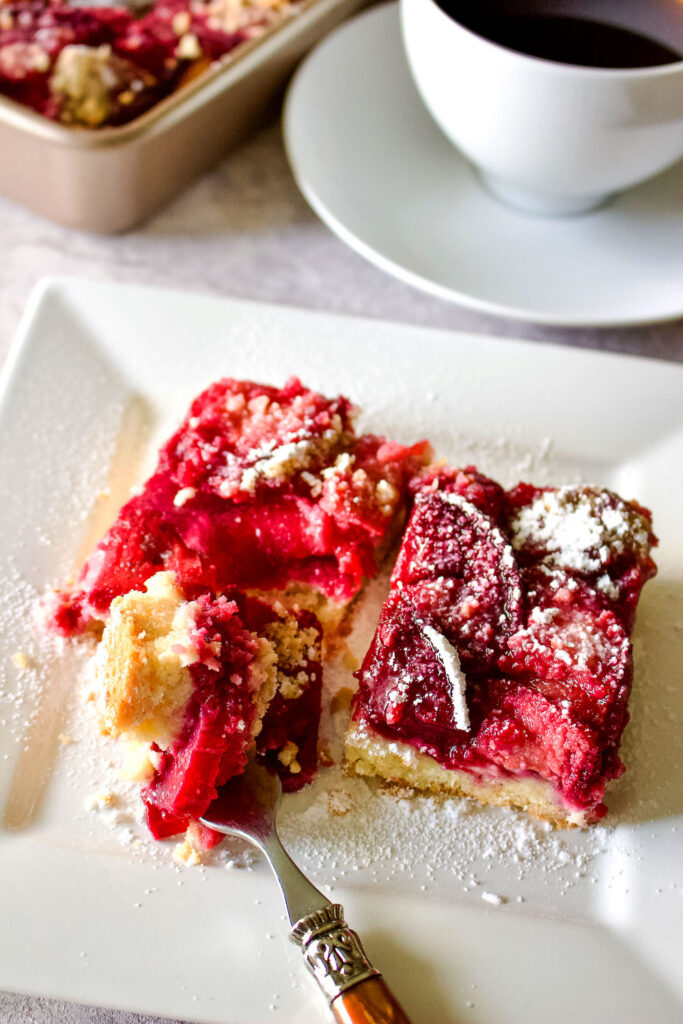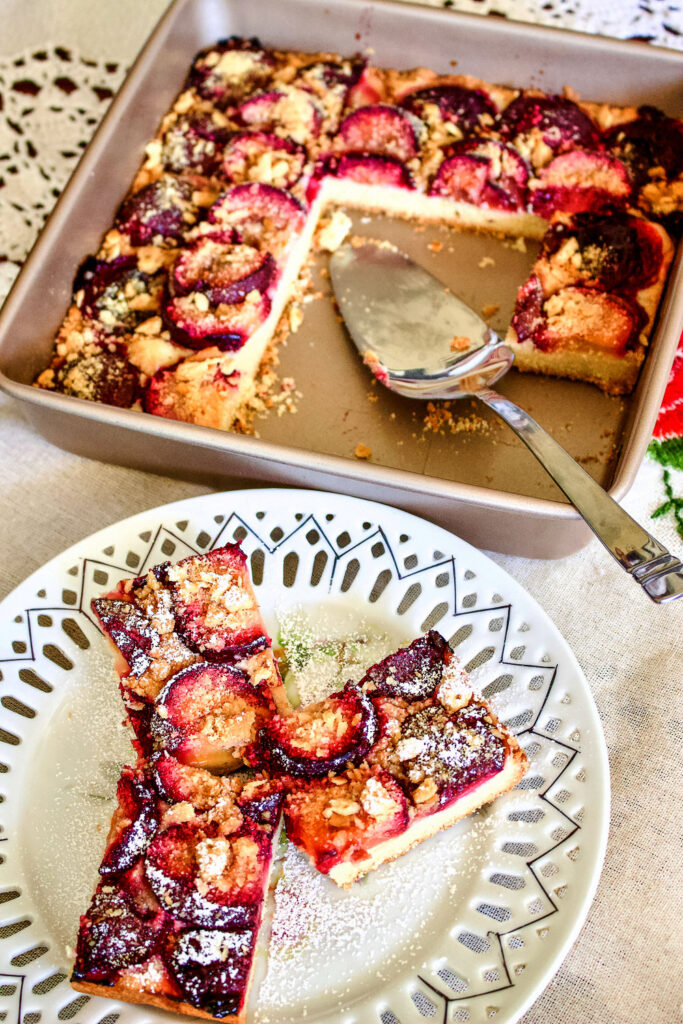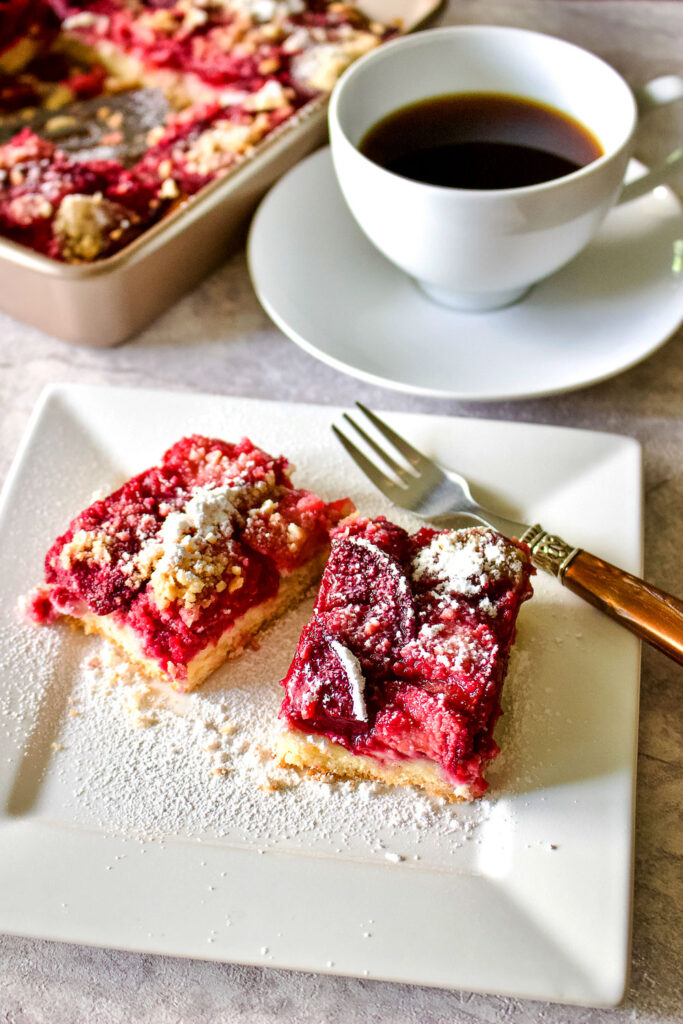German Plum Kuchen- Pflaumenkuchen is a summer recipe that uses fresh plums in season. This German recipe is traditional in Transylvania, and it is easy to make and delicious.

Jump to:
Why you will love this German dessert
I, personally, love this recipe. While plums are still in season, this recipe should be on the list of everyone who loves baking bars and using seasonal ingredients. The recipe comes from Transylvania, and it is specific to Saxon(German) cuisine.
Easy to make and incredibly delicious, the German Plum Kuchen is a little treasure, great for a lazy Sunday afternoon snack or dessert.
To make this recipe, I recommend Italian plums for a more traditional taste.

They are somewhat smaller and less juicy than American plums, that I find, in my opinion, a little too big for this recipe.

When I was growing up, bars or cookies used to be baked in my grandmother's home only over the weekends and served during the week as snacks or on special occasions.
The tray or the platter of desserts would sit quietly in the pantry, waiting for a guest to stop by and say hi.
She would then make coffee and serve desserts with it.

I love to share old recipes that come from my family or from the places I grew up. I think that old recipes teach us about old times. They provide a window into everyday life long ago.
You can learn what people ate, what utensils they used in the kitchen, what ingredients they could buy in the stores, and what cultural and culinary influences shaped them.
Sometimes you can also learn about their social lives because handwritten recipes frequently include the person's name from whom the writer got the recipe.
Such recipe collections are essential parts of family traditions but also of broader cultural traditions. They tell us stories of a vanished world and connect us to our past and our roots.
Here are some more recipes from Transylvania
- Plum Tart
- Apple Pie Bars
- Traditional Saxon Potato Tarragon Soup
- Jam Crescent Pastries
- Traditional Hungarian Goulash
- Easy Plum Coffee Cake-Summer Dessert
- Recipes of Cookies
Ingredients needed
- All-purpose flour: This is a flour that works for most baked goods, and most people have it in their pantries.
- Baking powder
- Granulated sugar
- Unsalted cold butter: as we will make a shortbread-type crust for this dessert, we will need very cold butter for the dough. Cut it into small pieces and work them into the flour and sugar.
- Large egg
- Italian plums: smaller fruits but full of flavor. If you cannot find them, use the type of plums you have available.
- Sweet graham crackers crumbs
- Powdered sugar to sprinkle on top of the bars
This dessert is straightforward. It has a shortbread crust on the bottom and fresh fruits on top. Bread crumbs are sprinkled over the plums to absorb the excess juice. That's it!

You can replace the plums with peaches. I do not see why they would not work. Also, there is not a ton of sugar in these bars, and I am not going to pretend that it is a fancy recipe. The ingredients are accessible and easy to put together, and the result is delicious.
Tip: The dough can be made in a food processor! It is a lifesaver in the kitchen! Amazon is an excellent place to start looking for a cheaper, reliable one if you don't have one!

How To Store
Place it in an airtight container and in a dry environment for up to three days. If there is a lot of humidity in the air, place the cake in the refrigerator.

More recipes to love
- German Peach Kuchen
- Decadent German Chocolate Cake
- Easy Apple Cake Bars
- Seven Layer Bars
- Triple Layer Chocolate Peanut Butter Cookie Bars
📖 Recipe

German Plum Kuchen- Pflaumenkuchen
Equipment
Ingredients
- 2 cups all-purpose flour
- ½ teaspoon baking powder
- ½ cup granulated sugar
- 1 stick unsalted cold butter
- 1 large egg
- 2 pounds Italian plums
- 1 tablespoon sweet graham crackers crumbs
- powdered sugar to sprinkle on top of the bars
Instructions
- Sieve the flour together with the baking powder and sugar.
- Work the cold butter into the mixture until it looks like bread crumbs.
- Add the egg.
- Mix to make a dough. Cover in plastic wrap and let it rest for an hour in the refrigerator.
- TipUse a food processor to mix the ingredients together. Pulse a few times for flour, baking powder, sugar, and butter to create a mixture that resembles bread crumbs. Add the egg and pulse a few more times until you obtain a dough.
- In the meantime wash and dry the plums, cut them in halves and remove the pits.
- Preheat the oven to 350F/180C.
- Use an 8x8 inch pan. (You do not need to butter the pan, as the dough has enough fat in it).
- Spread the dough on the bottom of the pan and place the plums on top of the dough in dense rows. Sprinkle them with the crumbs and bake for 40-45 mins. (the dough has to be baked, plums should still sweat)
- Let the pan cool, then cut the bars in squares and serve. Sprinkle powder sugar on top if you prefer.





Jana Fritzsche says
I am from Saxony, the town of Leipzig to be precise. Having grown up with exactly this cake, which my great-grandmother, grandmother, mum and now I have been making for generations. It is indeed absolutely delicious and still a stable in the bakeries, cafes and Sunday coffee table. I think it’s fab you posting this recipe but I really don’t understand what Transylvania (a German speaking part in Romania - totally different country) has to do with Saxon cake. It’s nothing to do with the area nor the cake. Saxons settled in Transylvania in the 11th century, a long long time before the cake emerged. I think it would have most people from Saxony gasp in bewilderment to hear someone claiming there was such a thing as Transylvanian Saxon plum cake as there has not been any actual cultural link between the two very different cultures and countries for centuries.
The Bossy Kitchen says
Hi Jana, Thank you for writing and visiting this recipe.
The Germans in Transylvania are indeed called Saxons(in English). In German they are called Siebenbürger Sachsen.Transylvania was under the Austro-Hungarian Empire for a long time, therefore there is a heavy influence of Austrian, German and Hungarian cuisines in Transylvania. It would be a mistake to believe that there is no actual link between the two cultures, as the Germans living in Transylvania where very careful to preserve their heritage. Many of them were educated in Germany, Austria or other countries occupied by the Austro-Hungarian Empire. These recipes traveled and were really well preserved.
The recipe comes from a book that my grandmother Herta used very often. It was a popular book in 1900s, made for young, freshly married women and it is called Siebenburgisches Kochbuch. The oldest version of this book that I was able to find is from 1959, but I am not sure when the first edition came out. The 1959 edition was printed in Bucharest.
This book is proof that the recipe was also used in Transylvania.I grew up with this recipe, like you did in Germany. As it is a recipe that my grandmother used to make, I think it is appropriate (based on my knowledge) to say that it is part of the Saxon cuisine of Transylvania.
As you can tell, the recipe is one of these gems that survived decades of good and bad history in Europe and also traveled with the Germans all over the world. Why do I say this? Because I have an American cooking book from 1955 called Saxon Cook Book and published by The Central Verband der Siebenbuerger Sachsen of the United States.
This little book has only recipes that arrived with the Transylvanian Saxons in early 1800's and forward. There is a recipe of plum cake in this book that is very close to the version I grew up with.
The Preface of the book says among other things:"Transylvania, the homeland of Saxons, is surrounded by many nationalities. Inevitably, the influence of environment had its effect in kitchen. Our forebears combined, adapted and adopted as their own, a combination of Austrian, Hungarian, and German cookery."
Jana says
thanks for your reply. This is very interesting and very close to what my father told me about the Siebenbürger. As said, it's not that there is no actual link but that the cultural links lay very very far back in history and have very very few relevance to any 'common' cultural links since the early 1900s. As said, it's fair to call it a Saxon plumcake, if you exclude the graham crackers (which cannot in any way replace the original and traditional "Streusel", made from butter, flour and sugar and which have a far more delicious taste than a cracker mix. They are a Saxon tradition on not only plumcake, but also apple and traditional Saxon Butterstreuselkuchen. I am sure the Siebenbürger have made a great job combining recipes ranging from the Austrian-Hungarian Empire and Germany they have collected along the way.However, no-one in Germany would associate a Pflaumenstreusel with anything other than Saxony. A bit like New York cheese-cake, a Brand-name so to speak or 5th generations Americans citing their Irish routes, whilst Irish people would insist they are Americans. Germans associate certain cakes with Saxony, same as we do with the sausages in the various regions. They are sacred. It's like the Budweiser comes from the Chech town of Budvar and is not a US Beer, though they claimed the name, or a real maple Syrup will never be anything other than Canadian, if they are anything to go by. We Saxons too, like to hold on to our traditions, it includes the culinary ones and two of our sacred foods are plum-cake and the Stollen, no matter who ran off with the recipe. It's only ever a real Stollen if it comes from Dresden, the capital of Saxony. Anything else, is not a 'Dresdener Christstollen', it wouldn't be a 'Dresdener Christstollen if it was made in Siebenbürgen, as the name and recipe is actually protected by law.
The Bossy Kitchen says
First of all, my recipe is not a Pflaumenstreusel. It is a Pflaumenkuchen. The original recipe requires bread crumbs on top of the plums, not streusel.I chose to use graham crackers, which are sweeter and more appropriate for the American readers. The most popular US bread crumbs available in the grocery stores have herbs and other ingredients that are not suitable for baking sweet desserts. Also, my recipe is not called Saxon plumcake, it is called German Plum Kuchen, and I only specified that it is traditional to the Saxon cuisine of Transylvania. There is no claim in my article that this recipe comes from Saxony, Germany, or that it is a traditional dessert in your country. I think the name is appropriate as it is indeed a German dessert, specific to the Saxons living in Transylvania and nothing else.
With all due respect, I am not sure why we are debating something that it is very clear to me: Saxony is part of Germany, there is a cake named Pflaumenstreusel that is specific to the region. While it might be quite similar to the recipe you know, my recipe comes from Transylvania and it was made by my Saxon grandmother. Saxons of Transylvania are not the same as the Saxons of Germany, as we already clarified, even if they are still Germans. Also, the recipe is not made with streusel, but with bread crumbs or graham crackers. It is possible that the recipe was adopted and adapted to the ingredients available in Transylvania and the streusel was replaced with simple bread crumbs, which makes this cake different than yours.
I think the "Saxon" word is what bothers you the most, but I think we clarified the semantics already. 🙂
Glenna says
Wow. The comments. Anyway, I was wondering why the total time to make this cake says 1 hour when there is a required resting time of 1 hour in addition to the total time.
The Bossy Kitchen says
Hi Glenna, Thank you for letting me know. I made the correction on the time, it was a technical glitch in the recipe card. And yes, the comments, I know...:-)
Jennifer says
I'm excited to try this! Part of my heritage is Germans from Russia and they have amazing Kuchen also! It is a bit different as it has a custard filling on top of the base and then the fruit on top. I'm excited to try your recipe as I have an egg allergy and can replace 1 egg but the 4 eggs in my family recipe is too much to replace. I love your knowledge of the history of your family
Cridtal says
Can you please clarify how much flour is needed? It says 2 cups or 8 oz, but 8 oz is only one cup. Thank you!
The Bossy Kitchen says
Hi Cristal, I actually modified the recipe and made it 8.8oz, instead of just 8. You will need 2 cups of flour, as 1 cup is usually about 4.4 oz or 120g. I also recommend a scale if you have issues measuring flour in cups. There are different ways to grab the flour from the bag and if you don't do it right, you might end up with too little or too much flour.A scale will give you the correct amount of everything.
Stephanie says
@The Bossy Kitchen, I just wanted to add my 2 cents here as I am an American baker using this recipe. The American measurement for a cup is always about 8oz. I used a total of 2 cups (16oz) and then had to double the sugar since you said 1/2 cup is 4oz- which if you think 2 cups is only 8oz doesn’t make sense. So I used my best guess and used 8oz of sugar 2 sticks of butter and 2 eggs.
Hopefully this helps other bakers!
The Bossy Kitchen says
Hi Stephanie, With all due respect, I have to disagree. 2 cups of all purpose flour are about 8.8 ounces or 250 grams. You can see here how flour is measured by weight. https://www.traditionaloven.com/conversions_of_measures/flour_volume_weight.html
Also, the recipe requires 4.2 ounces of sugar or 120 grams, or 1/2 cup and 2 tablespoons, roughly. Here is how to measure sugar: https://www.traditionaloven.com/conversions_of_measures/sugar_amounts.html
For example, 1 cup of brown sugar weights 7 ounces, 1 cup of powdered sugar is only 4.4 ounces and 1 cup of raw sugar is 8.8 ounces. Huge difference, right?
Yes, you are correct, 1 cup is 8 ounces, but liquid, not dry ingredients. Dry ingredients are measured by weight, in our case ounces or grams, while liquids are always measured by fluid ounces. That's why we measure liquids with the measuring glass cups, like these ones: https://amzn.to/3qsPmEI and dry ingredients with these tools: https://amzn.to/3BtiIcb.
I hope it makes sense. I would advice you try the recipe again, but following the instructions. The recipe is a good one.
Kristina Carr says
I am originally from Cologne, Germany and along the Rhine river therecare many little bakeries where one can stop and have Pflaumenkuchen during the fall season, but most make the cake with yeast. So I was sceptical to try your recipe, but I am so glad that I did. Although the cake is different than the one from my region, I love your version and it brings warm memories from home all the way to Florida. Thank you for inspiring me to try out something new.
The Bossy Kitchen says
You are so very welcome! Thank you for visiting! This recipe is indeed a treasure that made lots of people happy.
Christel Frey says
@Kristina Carr, hi Kristina. My family is from Germany and my mother always made this cake with a sweeter yeast dough. Unfortunately she has passed away and never wrote down her recipes. I’ve been looking for one with the yeast dough but haven’t found one yet. Do you have one you could share?
BTW, this recipe is wonderful too. I’m so glad I stumbled across it.
Maree Corda says
Hello there Gabriela,
Thank you for this recipe and I love all the history that comes with it. I have the cake cooking in the oven as I type this and pray it turns out well. My sister gave me the blood plums from her tree and I am baking this cake as a surprise gift for my German workmate also called Gabriela! I hope you dont mind but I used waffle cones, Biscoff and Pfeffernüsse Spice Cookies crushed in the food processor as the crumbs on top. I also added a touch of cinnamon, clove and ginger to the pastry as I just love these spices.
I am a little concerned as the recipe calls for 1kg of fruit but I barely used half of that amount as the tray was full. Just thought I would check if the plum measurement is possibly incorrect? 1 kilo = 1000grams
Many thanks again for sharing,
Regards Maree from Victoria in Australia.
The Bossy Kitchen says
Hi Maree, The recipe is correct.The idea is to have an abundance of fruit on top, as the pastry is quite bland, if you ask me. Probably your version came out awesome as you added so many delicious things. Next time try to put more fruit, it will come out bubbly and extra juicy! 🙂
Steve McCurdy says
In Fall 1974 I was a newly arrived American student about to spend a year at the University of Göttingen with the University of California Education Abroad Program. Some friends and I found a recipe, pulled some ripe plumbs off a tree on the Gutenbergstraße, and went to work. I think of that wonderful Kuchen, amazing year and those great friends--still in contact!--everytime I make this recipe. Thanks for awakening such joyful reverie.
Mit freundlichen Grüßen,
The Bossy Kitchen says
Wow, such a nice memory! Thank you so much for your note! It is indeed a good recipe!
Rosemary Sheel says
Made the plum kuchen yesterday. Very pleased with the results except my plums were not perfect...However the pastry made up for the plums!
My only comment would be that it took my super large food processor more than a few seconds to make the dough come together...maybe a minute. I was beginning to think that I'd have to add some ice water but then noticed that the dough was beginning to adhere.
Also fun was your experience with the Master Chef contest. You are right. It is not about the cooking. It is about the entertainment. Your cake looked great to me!
Gertrud I. says
I just found this recipe and I can’t wait to make it. It caught my eye because it was a Transylvanian Saxon recipe. I was born in Reichesdorf ( a small village in Transylvania). My entire family comes from there. We came to the US in 1978. I was only two years old, so I don’t remember much of the homeland, but my parents, aunts, uncles, and sisters kept many traditions alive. I speak Saxon as does most of my family. Thanks again for the recipe.
The Bossy Kitchen says
Hi Gertrud, What a wonderful story! Do you know that Reichesdorf village is also called Richis? You should take a trip to that area. It is absolutely lovely. Lots of foreigners live now in the village, including Americans. Here is an article about that, if you are curious: https://www.romania-insider.com/romania-richis-international-village/
I hope you also enjoy the recipe! ❤️
Connie Durant says
I was born in Schwabach Germany and love this dessert. I make a Pflaumenkuchen (I used to call it Zwetchgenkuchen) that comes close to your recipe. I never used Graham cracker crumbs. It's my favorite dessert and actually make mine a 11X15 pan and hate to share it. It was a favorite of my Dad's also. Anyway I'll have to try your recipe and double the size. And it's difficult to find Italian prunes around here. Thanks for sharing this recipe.
Barbara says
Going to make this tomorrow. Bought a bunch of plums from Aldi yesterday. Growing up, my German grandmother (from Sachsen) used to make Pflaumenkuchen every summer. Always loved it! Thank you for sharing this recipe.
Loretta says
I just made this plum kuchen. The recipe caught my eye because my dad actually came from Rode (now Zagar) in Transylvania, Romania. I made our "regular" plum kuchen and this one. While they are both delicious, I really like this Transylvanian recipe! I was hesitant about the graham cracker crumbs, but it really works and is delicious. Thank you for sharing this recipe from my dad's homeland - it's a keeper for me!